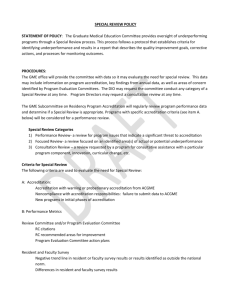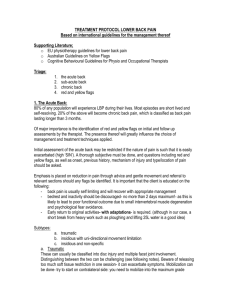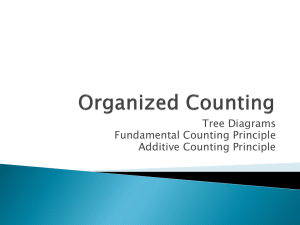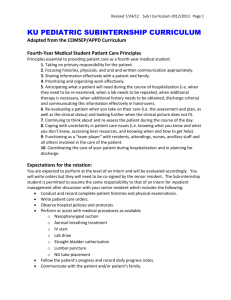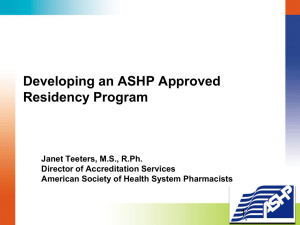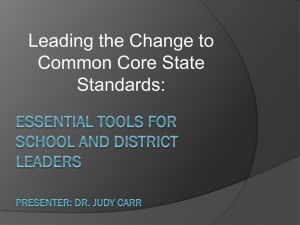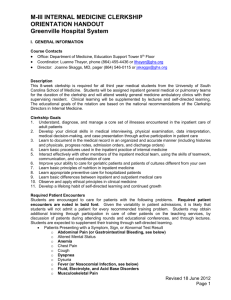Prog Eval Workshop
advertisement
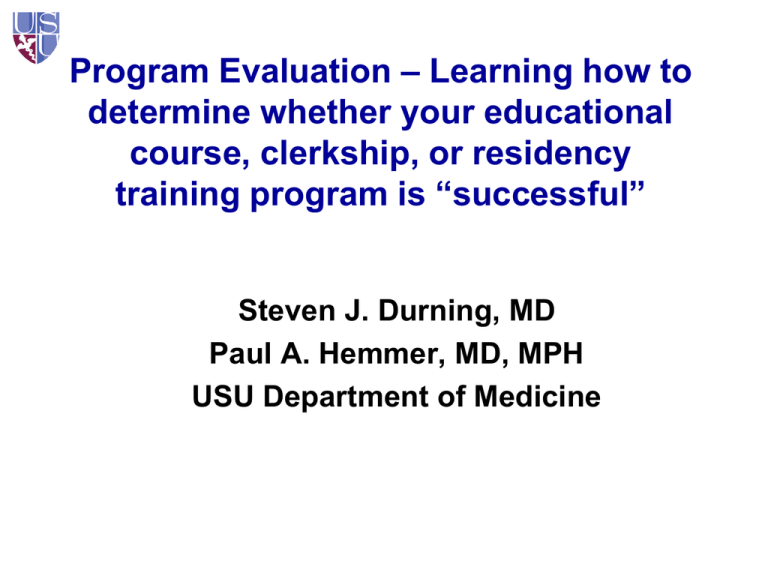
Program Evaluation – Learning how to determine whether your educational course, clerkship, or residency training program is “successful” Steven J. Durning, MD Paul A. Hemmer, MD, MPH USU Department of Medicine Acknowledgements • Louis N. Pangaro, MD • Dario Torre, MD, MPH, PhD Program Evaluation: Overview • Definitions • Purposes • Cardinal Questions – Why, What, Who, When, Where – HOW: Framework • New or Existing Programs • Examples, Activities throughout Educational Goals Curriculum Evaluation Individual Program Feedback / Grading Phases in evaluation: Distinctions • Assessment = making the observation – “assay” (measurement) • Evaluation = determining value – in context of expected learner/program level – an educational “diagnosis” • Grading/Feedback = taking an action – administrative/societal – educational intervention Program Evaluation • Systematic collection and analysis of information related to the design, implementation, and outcomes of a program, for the purpose of monitoring and improving the quality and effectiveness of the program.* • System level of examination • More than the sum of trainee data • Defining “success” and what explains it ACGME Glossary of Terms Accreditation Council for Graduate Medical Education Program Evaluation: Our Discussion Applies To: • Entire educational program – Medical School, Residency • A component – Basic Science yrs, Clinical yrs – Course, clerkship, year of residency • An aspect/session – Lecture series, Direct observation – Instituting “home visits” Program Evaluation: Why • • • • Accreditation bodies require it1 Determine strengths, weaknesses2 Competing goals of stakeholders Obtain and/or justify resources 1www.lcme.org 2Hayden, 2001 Program Evaluation: Goals Defining “Success” • Educational programs deal with change – Program Evaluation should examine for change • It is about understanding and action – To find the sources of strengths, weaknesses of the program, accreditation (External audience) – For decisions, local goals (Internal) – Trainees, Faculty, Program, System all contribute • Relating “inputs” to “outputs” – And back again Examples of Goal Questions • “I would be happy if I knew: is there consistency of evaluation across medical student clerkship training sites?” • “I would like to know: has reducing resident work hours affected student education?” Individual Activity: 5 minutes Exercise in Program Evaluation Worksheet Step 1 • Write down 1 Goal for your program • Complete: “I would be happy about my program if I knew…” – Or: “I want/need to know…..” • Be as specific as you can be: – Could you determine a Yes/No answer? Large Group Examples of Goals from You Activity: 5 minutes • Do you want to revise your Goal Question? • Do you want to pose a different question? How can we help you get a quality answer to your question? • Useful framework – Before, During, After (How) – Decide on the methods needed (What) • You should be able know what you can attribute to the program, and what is simply due to the trainee – Is the program “successful” because of you or in spite of you? Program Evaluation: How “Before, During, After” Framework Before During After • Baseline Your program Outcomes characteristics (Goals) This is akin to Table 1 • What the trainee brings in a Clinical to the program Research study • What has been their experience Program Evaluation: How Using the Framework • Assessments in the framework – Main focus today • Analysis: – Beyond scope of today’s talk – Understanding of analytic methods informs assessments you’ll choose • Quantitative or Qualitative analysis Program Evaluation: What • Multiple measures – No single measure can encompass all – Minimum of two assessments per “phase” – Quantifiable and Qualitative – Process and Product • Prioritize: Essential or Desirable? • Collect data under “controlled” conditions • What are you already doing? – If collected, done well? Program Evaluation: What Assessments in the Framework • Process measures – Curriculum content (What we do with trainees) – Process measures help explain outcomes • E.g., if you create an educational intervention, you need to know how many received it – Process measures are typically part of the “During” phase • Product measures – Outcomes (both primary and secondary) Program Evaluation: What Assessments in the Framework • Quantifiable – Numbers, counts (e.g., exams) • Qualitative – Words (interviews, written comments) – Help explain variance in outcomes • Both are key to • Finding unexpected results • Early warning of problems Program Evaluation: What Assessments in the Framework • Reliable • Internal consistency, Signal to noise • Reproducible • Valid • Confidence in the inferences drawn from information • Association with “outcome” • What are the sources of evidence to support validity? Durning, Hemmer, Pangaro. Teach Learn Med. 2007;19(3):308-18. Authenticity of Assessment (Methods) Assessing Professional Competence: from methods to programmes. Med Educ. 2005;39:309-317. Descriptive Evaluation (Teachers’ words, workplace assess) Does Unannounced SPs, Chart review Shows How Knows How Knows Simulations, OSCEs, mCEX Simulations, Simulators, Prosthetics MCQs/USMLE vignettes Miller (Acad Med. 1990) Authenticity of Assessments “Defense Against the Dark Arts” • “It is not, however, always possible to test mastery of important skills in a standard examination format. Wizards, for instance, must be competent in using the Patronus charm to repel Dementors…Professor Lupin recruits a Boggart to simulate a Dementor when teaching Harry Potter how to conjure a Patronus charm.” • “Professor Dolores Umbridge, an educational expert from the Ministry of Magic, makes the fundamental error of providing only a theory-based course for fifth year Defense Against the Dark Arts, a subject with performance-based assessment.” Harry Potter and Assessment. Jennifer Conn and Susan Elliott. The Clinical Teacher. 2005;2(1): 31-36. Before During After What: Before (Baseline) Measures • Identify, correct, control for differences • What is available? – Do you have to create something? – Does a clerkship director know preclinical performance measures in order to adjust for baseline student differences across sites? – Are academic issues shared among directors? Before During After What: During Measures • “Right” combination often program specific • Examples – ACGME “toolbox”, exams, monthly evaluation forms, surveys, peer evaluations, attendance, portfolios, reflections www.acgme.org Before During After What: After Measures Educational Outcomes: Kirkpatrick • • • • Level 1: learners’ views/reaction Level 2: changes in what learners know Level 3: change in what learners can do Level 4: impact, benefit to clients or organization (Patients, stakeholders) Kirkpatrick, D. L. (1967) Before During After What: After Measures--Examples • • • • • • • Board Certification/Examinations Placing graduates (fellowships, practice) Surveys (i.e. graduate or employer) Research and teaching productivity Academic appointments/advancement Disciplinary (i.e. NPDB, State Board) Patient Care (i.e. LDL, A1C targets, safety) Before During After Relate Before and During to After • Do not get lost in focusing on Outcomes • There should be a through-line connecting your After Measures to During and Before • And: – Program evaluation may not be linear – Program evaluation does not end with “After” but should feed information back at all stages – “The only program that is not changing is a dead program.” Program Evaluation: Individual Activity Exercise in Program Evaluation • “What to evaluate” worksheets – Steps 2-4 – After, During, Before Measures • 20 Minutes: Individual work – Build on your Goal Question • Facilitators available Program Evaluation Small Group Activity • Exercise in Program Evaluation: “What to evaluate” worksheet – Steps 2-4 – After, During, Before Measures • 15 minutes small group debrief Program Evaluation: Who • Gathering data can be performed by ALL • Academic managers play primary role in interpreting data • Consider all your stakeholders – Can expand resources, data for analysis Program Evaluation: Who Stakeholders for Residency • Residents – Education committee • Students – Program critiques • Faculty – Program resources, limitations – Overall resident strengths and weaknesses • Patients – Real or SP • Peers, Nurses, etc. • Chief Resident – Resident problems/progress • Clerkship director – Site resources/limitations – Faculty and resident morale – Faculty development • Oversight committees – Academic actions Program Evaluation: Who • Don’t go it alone – Create working groups, committees – Use variety of vantage points, different skills – Seek help • Statistical analyses • Qualitative analyses – Work within and across programs – Having others expect something is motivating! Program Evaluation: Where Resources-What you have, What you need • Time – – – – – Evaluation/feedback [verbal and written, interactive] Faculty development (e.g. Frame of Reference) Review/analyze/disseminate collected information Complete annual evaluations/reports To make scholarly work “scholarship” • Human resources – Coordinator, clerical support, committees, faculty, ancillary • Funding – Supplies, informatics, research, fac dev, offices, staffing Program Evaluation: When • Depends on program, resources – At least annually – Quarterly for recurring courses/clerkships – More frequently if implementing changes? • Ideally: collect, analyze, interpret continually – Criteria helpful to “triage”, monitor information – Reminder of “what” data to collect, need mechanism for detecting problems • When you perform PEv is key to finding concerns – Yellow Flags: closely follow – Red Flags: immediate attention Examples of Flags YELLOW RED Quantifiable Test scores down 1-2 SD Short program accreditation Long resident hours Test scores down 2 SD Minimal accreditation/warning Excessive resident hours Qualitative Learners not treated collegially Teachers give little feedback Multiple “near” misses Report of learner abuse Teachers ignore learners Multiple sentinel events Warning Flags: Example • Geriatrics Home Visit – Internal medicine clerkship students visit patient known to them in the home – Geriatrics teaching modules provided – Students must have plan for visit – Students submit reflective write-up – Required: if not done, grade affected • See Handout ACTIVITY Exercise in Program Evaluation 1) Steps 5-8 (15 min) Handouts: 1) Resources for Program Evaluation 2) Red and Yellow Flags Discussion (Small Groups) Take Home • Begin with defining SUCCESS – “I would feel really good about my program if I knew that…” • Before, During, After Framework – Try for 2 measurements for each phase • Advocate collecting at least 3 – Include qualitative and quantitative – Expect the unexpected (red, yellow flags) Take Home • Practicalities – Define needed resources (can you do it?) – Timing (include flags) • Analysis – Define unit of analysis for consistency (site, yr) – Try to explain the outcome • ANOVA and linear or logistic regression • Qualitative Getting started • Start with existing programs – You HAVE to do this • Don’t go it alone—create group process – Departmental, Interdepartmental, School – Decide on what needs to be assessed • Set deadlines, expectations – Annual reviews of courses, clerkships
